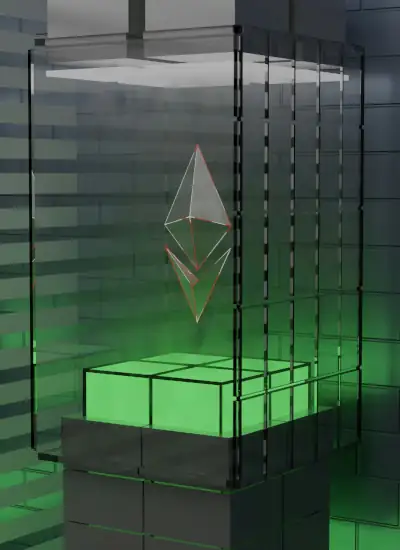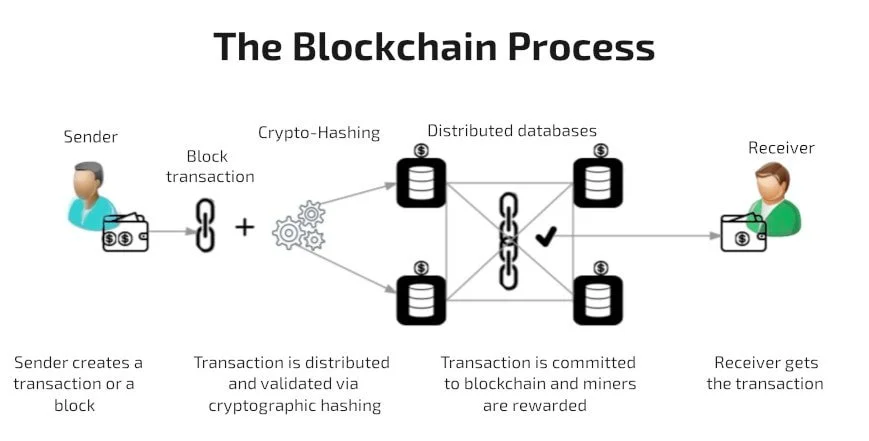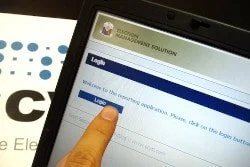
Are you curious about the technology that’s revolutionizing industries worldwide? Blockchain technology has emerged as one of the most transformative innovations of our time, powering everything from cryptocurrencies to supply chain management. Blockchain technology is transforming the way industries operate, offering a secure, transparent, and decentralized way to manage and record transactions.
So what is blockchain technology and what does a blockchain transaction look like? We will give you a detailed explanation in this blog post and answer all questions.
Table of Contents
What is Blockchain Technology? A Simple Definition
At its core, blockchain is a digital ledger that records transactions across a network of computers. Think of it as a shared digital notebook that everyone can see, but no one can alter once something is written in it. Each entry in this notebook is called a “block,” and when multiple blocks are linked together, they form a “chain” – hence the name “blockchain.”
Key Elements That Make Blockchain Unique
First of all, it’s not blockchain vs. distributed ledger technology. Blockchain is a type of distributed ledger technology (DLT) where data, particularly transactional data, is recorded in blocks that are linked together in a chain. This makes blockchain technology unique and it enables:
- Decentralization: No single entity has complete control
- Immutability: Once recorded, data cannot be changed
- Transparent Operations: All participants can view the history
- Secure Transactions: Advanced encryption protects all data

Unlock Your Business Potential with Certified Blockchain Consulting!
Dive into the future of technology with our team of certified blockchain experts. Simply pick the service you need:
Personalized Advice – tailored to your business needs.
Comprehensive Training – for you and your team.
Development Services – innovative solutions from the whitepaper to the finished blockchain.
Programming – with capabilities and tools to succeed.
TALK TO THE EXPERTS TODAYHow Does a Blockchain Transaction Work?
Blockchain works through a series of steps that secure and validate each transaction. Understanding blockchain transactions is easier than you might think. You can learn about blockchain on our website. But for now, let’s break down the process in short and simple terms:
- Transaction Request: Someone initiates a transaction (like sending cryptocurrency)
- Network Verification: The transaction request is broadcast to a decentralized network of nodes (computers) that verify it using consensus mechanisms like Proof of Work (PoW) or Proof of Stake (PoS)
- Block Creation: Verified transactions are grouped into a new block
- Chain Addition: The new block connects to previous blocks, forming a secure chain
- Completion: The data transaction becomes permanent and visible

Share this Image on Your Site:
The Technology Behind Blockchain Security Explained
Blockchain uses advanced cryptography to ensure security. Each block contains:
- A timestamp
- Transaction data
- A unique identifier (hash)
- The previous block’s hash

Share this Image on Your Site:
This creates an unbreakable chain of information that’s virtually impossible to tamper with.
Types of Blockchain Networks You Should Know
Not all blockchains are created equal. Here are the main types of blockchain networks, each with unique characteristics and uses:
Public Blockchain Networks
Public blockchains, like Bitcoin and Ethereum, are open to everyone. Anyone can participate in transaction verification and view the ledger.
Private Blockchain Solutions
Private blockchains are restricted to specific users or organizations. They are less decentralized but offer:
- Faster transaction speeds
- Greater privacy controls
- Customizable permissions
Consortium Blockchain Systems
Consortium blockchains are controlled by a group of organizations, without complete decentralization but:
- Operated by multiple organizations
- Combines public and private features
- Perfect for business partnerships
Hybrid Blockchains
Hybrid blockchains combine features of both public and private networks, offering:
- Customized level of access
- Privacy for participants

Share this Image on Your Site:
Real-World Blockchain Applications
Blockchain technology extends far beyond cryptocurrencies. Here’s where it’s making an impact:
Cryptocurrencies

Blockchain forms the foundation of cryptocurrencies like BTC, ETH, USDT, or SOL. The advantages of using crypto are:
Enhanced Security
Decentralized digital transactions without intermediaries
Personal Freedom
Financial Services

Blockchain in finance offers:
Digital Payments: Faster, cheaper international transfers
Smart Contracts: Automated, self-executing agreements
Asset Trading: 24/7 market operations
Supply Chain Management

Blockchain enhances transparency and traceability in the supply chain, allowing companies to:
Inventory management
Tracking products from origin to delivery
Authenticity verification
Healthcare Solutions

In healthcare, blockchain can improve patient data integrity and privacy for:
Secure patient records
Medical supply chain tracking
Clinical trial management
Government Services

Blockchain in government services can enhance transparency and security in:
Tax collection
Digital voting systems
Property records

Unlock Your Crypto Potential: Become a Market Maverick with Expert Coaching!
Are you ready to dive into cryptocurrency but need some advice? With our personalized 1:1 coaching, you’ll learn to:
Understand – the fundamentals of cryptos and how they impact value.
Navigate – through the volatile crypto market with confidence.
Identify – new lucrative opportunities that maximize returns.
Manage – exchanges and risk to protect your investments.
BOOK EXPERT COACHING NOWBenefits of Using Blockchain Technology
Leading companies like JPMorgan Chase (in finance), LVMH (the luxury goods giant), or IBM (in the technology sector) already using the advantages of blockchain. Here are the major benefits:
1. Enhanced Security
- Cryptographic protection
- Decentralized storage
- Tamper-proof records
2. Improved Transparency
- Full transaction visibility
- Auditable history
- Real-time updates
3. Cost Efficiency
- Reduced intermediary fees
- Automated processes
- Lower operational costs
Common Blockchain Challenges and Solutions
Despite its benefits, blockchain technology has the following challenges:
- Scalability: Handling increased transaction volumes can be slow and costly unless we use layer-2 scaling solutions
- Energy Usage: Reducing power consumption through new types of consensus mechanisms like Proof-of-Stake (PoS), which is used by Tezos
- Integration: Connecting with existing systems is a challenge unless we use hybrid blockchain models

Unlock the Code: Master Blockchain Programming!
Dive into the world of decentralized technology with our comprehensive online programming courses. Learn at your own pace and get:
Access – to expert instructors.
Interactive – coding exercises.
Vibrant – community of like-minded learners.
Certified – receive your recognized diploma.
ENROLL TODAY AND TRANSFORM YOUR FUTURE!The Future of Blockchain Technology
Blockchain technology continues to evolve, with promising trends and exciting developments on the horizon:
Emerging Trends
- Web3 Integration: Decentralized Internet applications
- Integration with IoT: Securely connects and manages IoT devices, enhancing efficiency
- Smart Contracts: Self-executing contracts that reduce the need for intermediaries
- Green Blockchain: Sustainable Consensus Mechanisms
- Cross-Chain Operations: Improved blockchain interoperability
Industry Adoption
- Banking Revolution: Central bank digital currencies and DeFI (decentralized finance)
- Supply Chain Innovation: End-to-end tracking solutions
- Healthcare Transformation: Unified patient records
Conclusion: Why Blockchain Matters
Blockchain technology represents more than just a technological advancement – it’s a fundamental shift in how we handle digital trust and transactions. Whether you’re a business owner, investor, or simply curious about technology, understanding blockchain is becoming increasingly important in our interconnected world.
Ready to learn more about blockchain technology?
Learn Blockchain Technology!
Blockchain Training in Small Classes
Webinars about Bitcoin and Coding
Blockchain Courses at University Level
Get free Blockchain Tips!
Get monthly tips on how blockchain can help your business.
On top, you’ll get our free blockchain beginners course right away to learn how this technology will change our lives.
Frequently asked questions
Is it blockchain or block chain?
The word is ‘blockchain’, a combination of two separate words. Blockchain is a special kind of distributed ledger technology. The word came about as a result of the mapping of blocks of data to other preceding blocks to form a virtual chain of encrypted verified data. Splitting the word in two will create a different meaning entirely. So, it’s best we stick with blockchain for easy comprehension.
What is a blockchain company?
A blockchain company is a technology firm that builds its business or products around blockchain technology. The evolution of blockchain technology has stirred the emergence of a lot of these companies in the past decade. Blockchain companies offer a diverse range of services. Ranging from operating a cryptocurrency exchange where digital currencies can be bought and sold to those dedicated to creating digital identities.
What is blockchain currency?
A blockchain currency is also a cryptocurrency. They are a relatively new form of virtual money built to run on a blockchain network. Bitcoin, Ethereum, XRP, are some of the popular cryptocurrencies around today. There are a wide variety of these digital currencies including a growing niche known as Decentralized finance-backed tokens. Examples of these tokens include Uniswap, PancakeSwap, and other relatively new tokens.
What is a blockchain platform?
A blockchain platform is a decentralized governance and data infrastructure that permits users to transact with one another without the need for an intermediary. Through a blockchain platform, two or more people can conduct transactions directly, and securely, thereby enjoying the speed and low cost of transactions in relation to existing payment platforms. A blockchain platform can be used for more transactions other than cash transfers.
How many blockchains are there?
It is difficult to keep an accurate count of the number of blockchain networks operating today. First, there are private and public blockchain networks that serve various purposes. New blockchain networks are designed on a daily basis, all seeking to outrank the other in terms of gaining market share. Examples of the popular blockchains around today include the 6 different types of blockchain networks notably; centralized blockchains, decentralized blockchains, public distributed ledgers, private distributed ledgers, consortium blockchains, and hybrid blockchains.
Some of the top cryptocurrencies also run on their own specialized blockchains. Examples of these include the Bitcoin blockchain, Ethereum network, Binance Smart Chain, and Polkadot to mention a few.
What is the main purpose of blockchain technology?
Blockchain enables secure, transparent, and decentralized record-keeping of transactions without requiring intermediaries.
Is blockchain only used for cryptocurrency?
No, blockchain has numerous applications beyond cryptocurrency, including supply chain management, healthcare records, and digital voting systems.
How secure is blockchain technology?
Blockchain is highly secure due to its cryptographic nature, decentralized structure, and immutable record-keeping.
What makes blockchain different from traditional databases?
Unlike traditional databases, blockchain is decentralized, immutable, and transparent, with no single point of control or failure.


